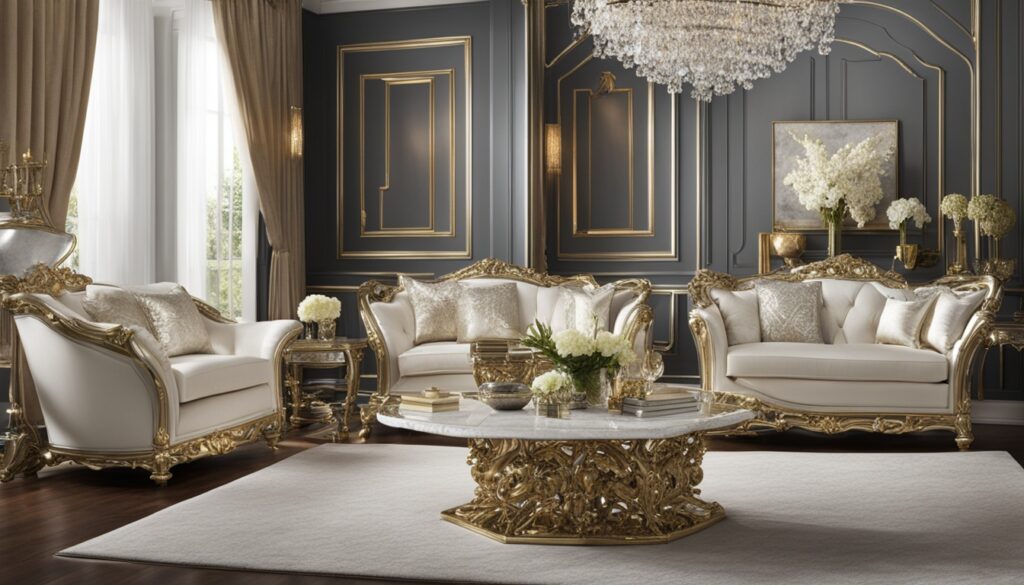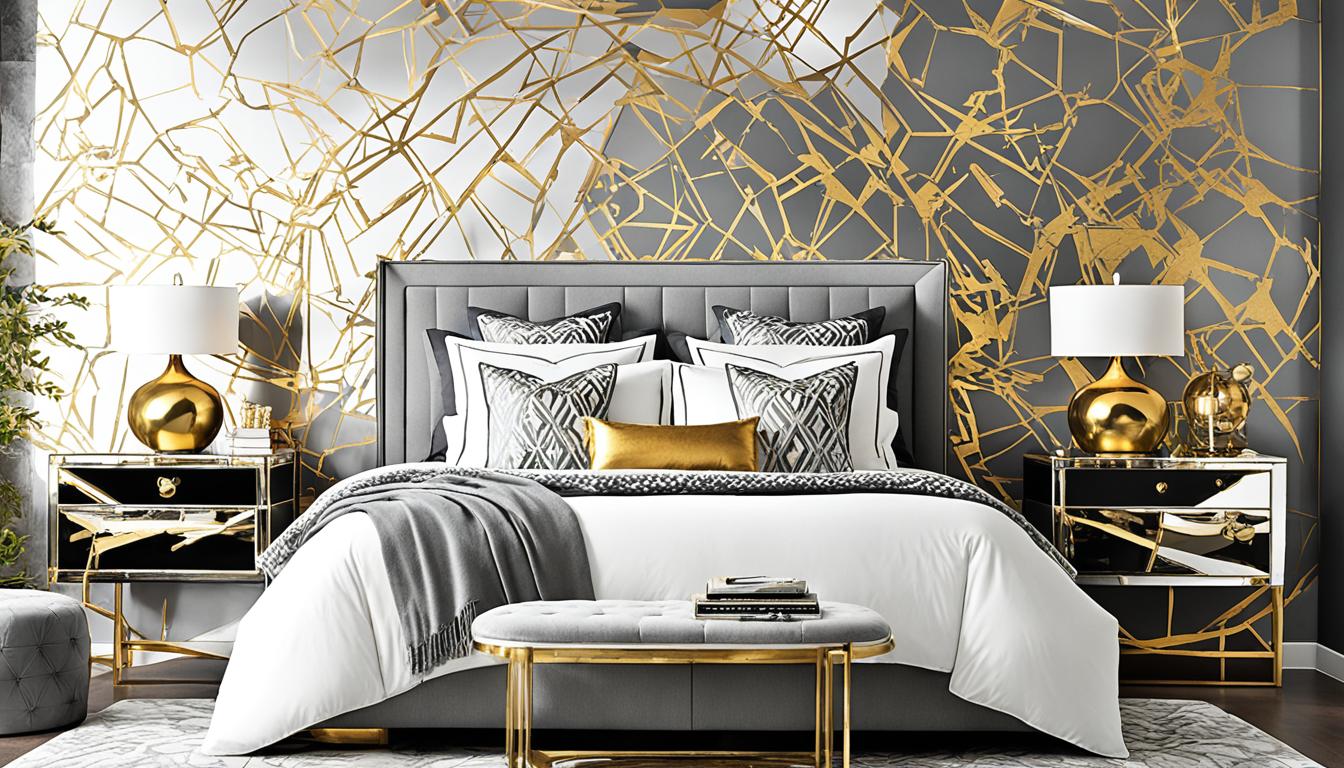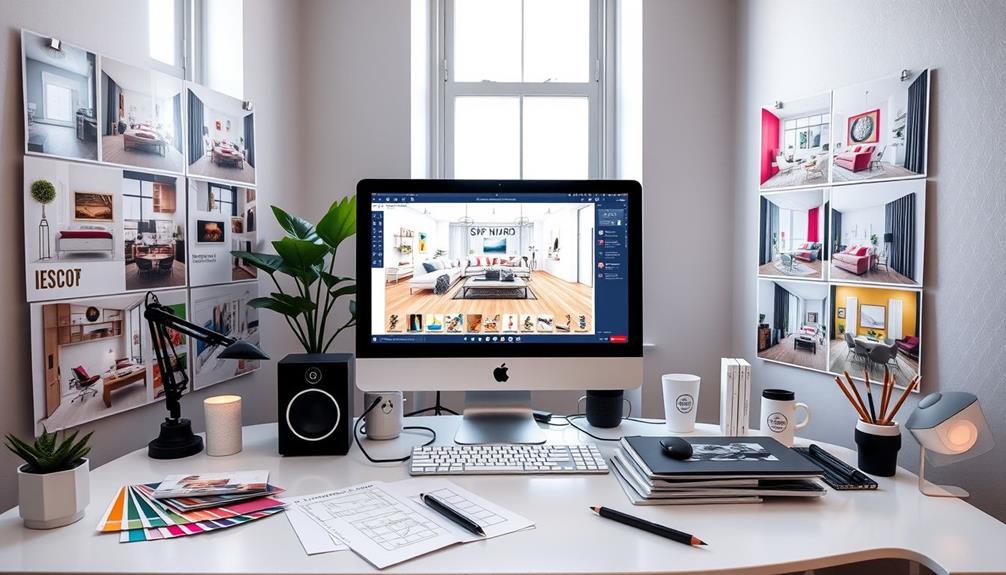Combining silver and gold in your home decor is not just a fleeting trend; it’s a stylish way to bring elegance and sophistication into your space. As the popularity of metallic home decor continues to rise, especially since 2016, understanding how to mix silver and gold interior design effectively is key to achieving a cohesive and luxurious ambiance. Pinterest showcases countless ideas that inspire you to explore this dynamic duo.
To create an inviting atmosphere, it’s essential to balance warm and cool tones, ensuring that the metals complement each other while maintaining visual harmony. By limiting your choice of metal finishes to a maximum of three, you can avoid a chaotic look and instead cultivate a refined aesthetic. Remember, blending textures—matte, polished, and hammered—can elevate your decor and add depth to your design. So, whether you’re looking to add a dash of shimmer to a cozy nook or transform your entire living space, mastering the art of mixing silver and gold will help you achieve that desired luxurious flair.
Key Takeaways
- Mixing metals in decor is an increasingly popular trend that adds sophistication.
- Maintain a balance between warm and cool tones for harmonious decor.
- Limit the number of metal finishes to three for a cohesive look.
- Use variations in texture, such as matte, polished, and hammered, to enhance visual appeal.
- Aim for a 70/30 ratio of dominant to secondary metal tones when mixing.
- In smaller spaces, stick to two metal tones to avoid overcrowding.
- Incorporate accent colors like blue for added depth and style in metal decor.
The Elegance of Mixing Silver and Gold in Decor
Blending silver and gold in home decor creates an inviting atmosphere that strikes a balance between chic and sophisticated. This visual appeal arises from the unique juxtaposition of warm gold tones against cooler silver shades. The allure of mixing these two metallic finishes has made it a hot trend across various interior design platforms, especially on Pinterest, where you can find a wealth of ideas and inspiration.
When considering how to mix silver and gold interior design, remember that simplicity can often make the strongest impact. For smaller spaces like bathrooms, it’s advisable to limit choices to two metal finishes. In larger areas, such as living rooms, you can creatively incorporate up to three different finishes. The key lies in choosing one dominant metal and adhering to guidelines like the 70/30 rule, which helps maintain harmony in your decor.
This trend extends beyond traditional home decor, influencing other industries such as wedding styles and glam decor, showcasing its versatility. Using both silver and gold elevates spaces and offers a unique appearance, enabling you to add a touch of elegance to your interiors. Achieving this bold yet sophisticated style choice not only brings personality to your home but also invites guests to admire the design finesse.

Understanding Metallic Finishes in Interiors
When embarking on modern interior design with silver and gold, understanding different metallic finishes in interiors becomes crucial. The variety of finishes, such as matte, glossy, brushed, and polished, provides a canvas for creating diverse atmospheres in your home. Each finish imparts a unique quality, allowing you to express your personal style.
For instance, a polished gold piece radiates opulence, enhancing the elegance of a space. In contrast, a brushed silver finish evokes a contemporary vibe, promoting a more casual yet sophisticated aesthetic. Popular metal finishes like stainless steel, brushed nickel, and polished chrome add versatility and can coordinate beautifully with gold or silver accents.
Mixing metals has gained popularity, deviating from the traditional single-tone approach. This trend not only adds visual interest but also infuses personality and depth into your interior design. Using elements like aged bronze beside brass or incorporating gunmetal accents with polished chrome creates a layered look that feels both cohesive and dynamic.
To effectively mix metallic finishes in interiors, start by selecting a dominant finish, then choose one or two accent metals. Think about the undertones; warm metals like brass and copper can blend seamlessly with cooler shades like silver and nickel. Lighting conditions play a significant role in how these finishes appear, enhancing their reflective qualities and overall appeal.
Choosing the right balance and placement is essential to achieve a harmonious blend. Aim for a limited selection of two or three finishes to avoid creating a chaotic environment. Practical application might include using chrome for bath faucets paired with gold tones in other elements, providing elegance and warmth to the bathroom. Repeating the same finish in multiple areas establishes a pleasing rhythm throughout the space.

How to Mix Silver and Gold Interior Design
Mixing silver and gold in your decor can create a luxurious and sophisticated ambiance. It is essential to maintain the right balance for a harmonious look. Start by incorporating silver and gold accents wisely, ensuring that neither metal overwhelms the other. This balance can be achieved through thoughtful selections of complementary pieces. For instance, pairing gold curtains with a sleek silver chandelier elevates the elegance of your space. Consider using aipowered interior design tools to help you visualize how different silver and gold elements will work together in your space. These tools can also provide suggestions for specific pieces that will complement each other seamlessly. Additionally, don’t be afraid to experiment with different textures and finishes to add depth and visual interest to your decor.
Choosing the Right Balance
When figuring out how to mix silver and gold interior design, consider the scale of your area. In smaller spaces, limit your use to two different metal finishes. Larger spaces, on the other hand, can accommodate up to three metals. Applying the 70/30 rule suggests that one metal should dominate about 70% of the aesthetic, while the remaining 30% can feature other accents. Alternatively, the 60/30/10 rule adds further versatility, allowing for an additional metal or color.
Utilizing Texture and Finish for Depth
Incorporating varied textures and finishes adds depth to your decor. Use a mix of matte and glossy metallics to create visual interest, enhancing the overall aesthetic of your space. Consider mixing items like decorative accessories that shine with soft fabrics that have a subtle sheen. In addition, color temperature influences how the metals interact. Warm metals like gold should complement cool ones like silver for a cohesive look. This interaction is especially relevant when using metal picture frames which come in a variety of finishes, such as Silver, Gold, and Bronze.

| Metal Finish | Recommended Pairings | Ideal Usage |
|---|---|---|
| Gold | Silver, Brass | Warm spaces with red/brown hues |
| Silver | Gold, Chrome | Cool spaces with blue/green hues |
| Brass | Gold, Copper | Neutrals and earth tones |
Incorporating Silver and Gold Accents
Adding metallic elements to your home can elevate your decor, particularly when incorporating silver and gold accents. Choosing the right accent pieces not only showcases these metals, but it also creates a polished and sophisticated atmosphere. By selecting smaller items such as candlesticks, vases, and art frames that exhibit both silver and gold, you ensure that these accents enhance rather than overwhelm your space.
Accent Pieces that Shine
Focus on accent pieces that embody the elegance of both metals. A well-placed decor item can significantly enhance your home’s overall aesthetic. Consider the following options:
- Candlesticks featuring both gold and silver finishes
- Mixed metallic vases that serve as stunning focal points
- Picture frames that harmoniously blend silver and gold tones
Each of these accent pieces can create striking visual interest while maintaining a cohesive look throughout your home. Distributing these items evenly across different surfaces promotes balance and encourages a flow within your decor scheme.
Combining Accessories for Visual Cohesion
To achieve visual cohesion in home decor, focus on pairing accessories that either share similar styles or complement contrasting elements. For instance, pairing modern geometric gold lamps with sleek silver vases can lead to a curated and intentional appearance. Keeping the following tips in mind can enhance your decor:
- Utilize pieces with different textures and finishes to add depth.
- Mix metals such as polished brass with satin nickel for dynamic contrast.
- Ensure that each type of metal appears in multiple locations to establish a cohesive aesthetic.
By carefully considering your accent pieces and their arrangement, you can craft an environment that radiates sophistication and warmth while effectively incorporating silver and gold accents throughout your home.

| Accent Piece | Material Combination | Stylistic Effect |
|---|---|---|
| Candlesticks | Gold and Silver | Elegant, warm glow |
| Vases | Mixed Metallics | Cohesive, eye-catching |
| Picture Frames | Brass and Nickel | Timeless, sophisticated |
Creating a Silver and Gold Color Scheme
Designing a captivating silver and gold color scheme requires a thoughtful approach. Begin by considering the interplay between lighter and darker shades. Using a combination of silver and gold can highlight the unique qualities of each metallic finish. For instance, while polished nickel provides a sleek look, oil-rubbed bronze can create a more rustic feel, giving the space character.
When incorporating metals, it’s beneficial to avoid a matchy-matchy approach. A recommended practice involves mixing two or three different metals, such as chrome and gold accents, to foster a diverse yet cohesive visual experience. This method adds depth to your decor while ensuring that your silver and gold color scheme remains engaging.
Adding non-metal materials can also break the monotony created by the metallic elements. Consider incorporating fabrics or wallpapers that feature metallic accents. This detail subtly ties together the hardware finishes, enriching the overall aesthetic. Textures play a significant role in harmonizing the various elements; combining delicate and bold textures enhances the silver and gold color scheme.
It’s essential to think of metal finishes as colors to effectively harmonize them throughout your home. For instance, matching metallic tones with your existing color palette ensures that the silver and gold accents complement the space instead of overwhelming it. Spacing out these metallic fixtures prevents a cluttered appearance, allowing each element to shine.

| Metal Finish | Best Application | Texture Options |
|---|---|---|
| Polished Silver (Chrome) | Kitchens, Modern Decor | Smooth, High-Gloss |
| Brushed Nickel | Classic, Timeless Spaces | Satin, Textured Finish |
| Gold Accents | Statement Pieces, Glamorous Touches | Bright, Reflective |
| Oil-Rubbed Bronze | Rustic, Vintage Style | Matte,Muted |
Adapting your metallic choices to the overall color scheme can create a harmonious environment. Consider warm and cool tones for a visually appealing contrast in your space. By carefully planning your silver and gold color scheme, you can achieve a sophisticated and inviting atmosphere that captures the essence of modern interior design.
Luxury Interior Design Trends Featuring Metallics
In the world of luxury interior design trends, the integration of metallics such as silver and gold has become a defining feature. These materials add a sense of richness and sophistication that instantly elevates any space. Designers are now embracing the concept of blending silver and gold in home decor to create visually captivating environments that attract the eye and stimulate the senses.
Current Trends in Luxury Decor
Today, metallics like gold, silver, and even copper are trending prominently in high-end decor. The use of these finishes not only creates a shimmering effect but also enhances the overall brightness and spaciousness of a room. Mixing metals provides a unique texture and visual interest that contributes to the chic aesthetic of modern interior design with silver and gold. For instance, vintage chandeliers and striking metallic wallpapers have gained popularity for their ability to instill a sense of opulence.
Influence of Silver and Gold in Contemporary Design
Silver and gold, once typically reserved for accessories, have expanded their reach into furniture and lighting designs. Elements such as gold leaf embellishments and bold statement pieces, including gold tubs and elaborate chandeliers, are now essential components of modern luxury homes. These metals harmonize beautifully with glass elements, creating a fresh, open ambiance that makes interiors feel more inviting. Experimenting with these metallics allows for an engaging blend of elegance and eclecticism, achieving a balanced look that showcases personal style.

| Metallic Element | Application | Design Impact |
|---|---|---|
| Gold | Lighting fixtures | Creates warmth and richness |
| Silver | Furniture accents | Adds a sleek, modern touch |
| Copper | Farmhouse sinks | Brings rustic charm to kitchens |
| Brass | Drapery rods | Offers a vintage appearance |
| Mixed Metallics | Vignettes | Enhances visual interest and balance |
Silver and Gold Furniture Pairing Tips
Pairing silver and gold furniture creates an inviting and sophisticated atmosphere in your living spaces. Start by establishing a focal point to guide your selection. This can be a striking piece, such as a gold accent chair alongside silver side tables, which sets the tone. Achieving a harmonious balance with silver and gold furniture pairing ensures that neither metal overpowers the other.

Pay attention to the size and scale of your pieces. Large statement furniture can work beautifully when complemented with smaller accent pieces, giving a layered effect. Consider incorporating textured metals like hammered or antiqued finishes, as these can introduce visual interest and depth. Embracing different finishes allows for a more dynamic look while elevating the elegance of your decor.
It’s wise to distribute your silver and gold furniture around the room rather than isolating certain pieces. This strategy promotes a cohesive look without creating visual clutter. For the best results, choose one main metal, like a dominant silver centerpiece, and let your gold pieces serve as supporting elements that enhance your overall design.
- Mix two or three metals for a balanced aesthetic.
- Spread various finishes around the room for harmony.
- Consider design flexibility; there are no strict rules.
- Incorporate textures for added intrigue.
Experimenting with silver and gold furniture pairing can significantly beautify any room. Explore different combinations and find what resonates with your personal style while ensuring a sophisticated and polished finish to your decor.
Conclusion
In summary, blending silver and gold in home decor can elevate your living spaces to new heights of sophistication. These metals each bring their own character—gold adds warmth while silver lends a cooler touch. By thoughtfully choosing a dominant metal, you can create a solid foundation for your decor while allowing for the playful introduction of other metals, such as copper and brass, to add texture and depth.
As you’ve seen throughout this article, the appeal of mixing metals isn’t just a trend; it’s a celebration of individuality and creativity in interior design. Whether you’re selecting unique furniture pieces or integrating metallic accents through textiles and accessories, the versatility of silver and gold can beautifully enhance any style—from modern to vintage. Don’t hesitate to experiment; after all, the journey of crafting your personal design statement should be just as enjoyable as the final result.
With 2024 marking a bold shift towards mixed metal decor, now is the perfect time to embrace blending silver and gold in your home. These elements provide not only aesthetic appeal but also durability and timelessness, ensuring your decor remains both fashionable and functional for years to come.









